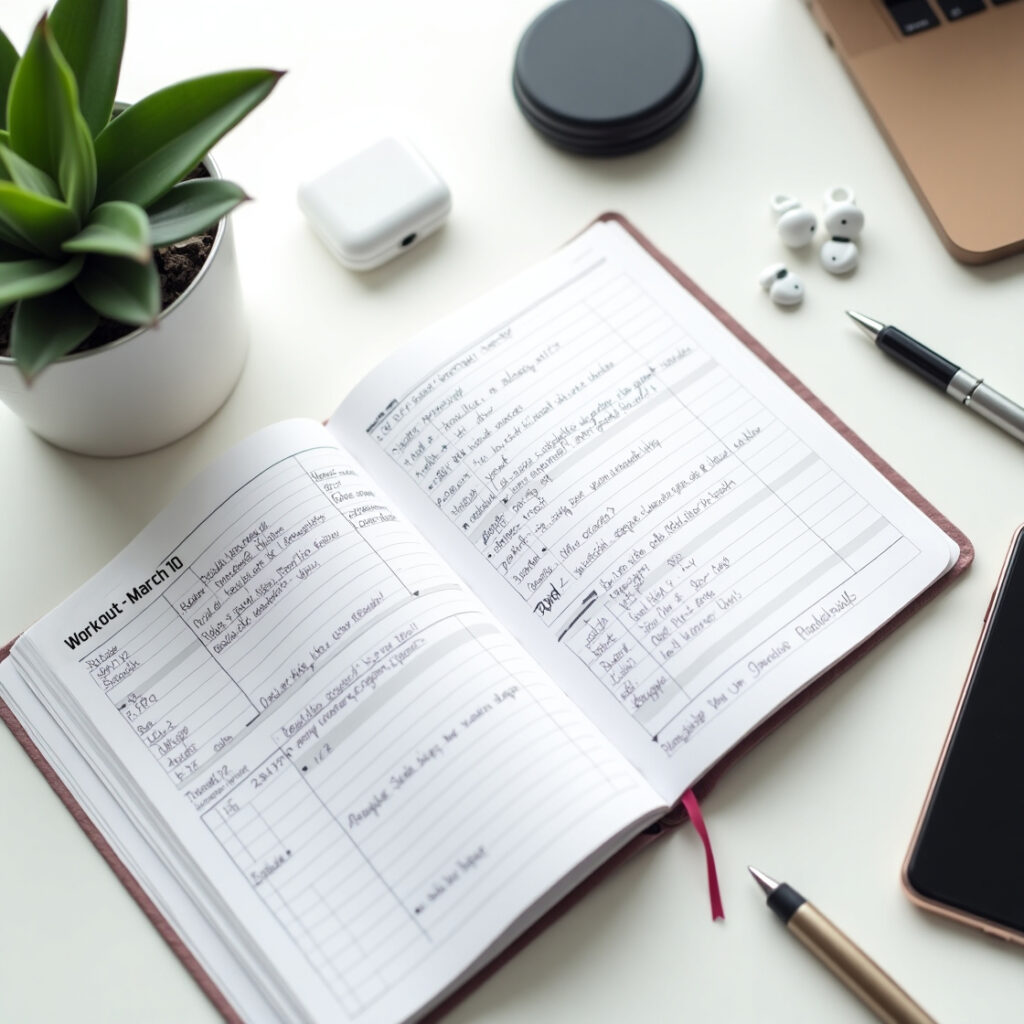Keeping yourself motivated for home workouts can often feel like a constant struggle. Without the energy of a gym, the accountability of a trainer, or the social pressure of workout buddies, it’s easy to let exercise slide down your priority list. You’re not alone if you’ve found yourself making excuses, skipping workouts, or struggling to maintain consistency with your home fitness routine.
The good news? Home workout motivation isn’t about having superhuman willpower or perfect circumstances. It’s about understanding the psychology behind procrastination and implementing proven strategies that make exercise feel less like a chore and more like a natural part of your day.
This comprehensive guide will show you exactly how to conquer workout procrastination and build lasting motivation for achieving your home fitness goals
Contents of the article
Understanding Home Workout Procrastination: Why We Avoid Exercise
Setting SMART Goals for Home Fitness Success
Creating a Home Workout Routine That Sticks
Finding Your Home Workout Accountability Partner
Tracking Progress: Measuring Home Workout Success
Reward Systems That Reinforce Home Workout Habits
Overcoming Common Home Workout Obstacles
Building Long-Term Home Workout Motivation
Frequently Asked Questions About Home Workout Motivation
Your 30-Day Home Workout Motivation Challenge
Creating Your Personal Home Workout Motivation System
Conclusion: Your Journey to Consistent Home Fitness
Understanding Home Workout Procrastination: Why We Avoid Exercise
Before diving into solutions, it’s crucial to understand why workout motivation at home feels so challenging. Recognizing these underlying factors helps you address the root causes rather than just fighting symptoms.
The Psychology Behind Exercise Procrastination
If you skip a gym workout, you might feel guilty about wasted membership fees or disappointing a trainer. However, when you’re exercising at home, you don’t face the same external pressure or immediate negative repercussions for missing a session. This makes it much easier to rationalize postponing exercise.
Decision Fatigue and Mental Energy Your home environment constantly demands decisions throughout the day. By the time you’re ready to exercise, your mental energy may be depleted, making it harder to push through resistance and start your workout.
Environmental Distractions Home environments are full of competing priorities and distractions. The dishes need washing, emails require responses, and the couch looks incredibly inviting. These environmental cues can derail your workout intentions before you even begin.
Lack of Social Accountability Humans are social creatures, and we often perform better when we have external accountability. When you’re working out alone at home, you miss out on the motivational benefits of social pressure and the shared commitment that gym environments naturally provide.
Common Home Workout Motivation Killers
All-or-Nothing Mindset Many people are convinced that only intense, hour-long workouts will deliver results.
This perfectionist mindset leads to skipping exercise entirely when time is limited, rather than doing shorter, manageable sessions.
Unrealistic Expectations Setting overly ambitious goals from the start, or comparing your beginnings to someone else’s more advanced stage, often leads to frustration and eventual burnout. Unrealistic expectations set you up for perceived failure, which kills long-term motivation.
Lack of Clear Structure Without a predetermined plan, each workout session requires decision-making about what exercises to do, how long to exercise, and what equipment to use. This mental overhead creates resistance and makes it easier to procrastinate.
Setting SMART Goals for Home Fitness Success

Effective goal setting is the bedrock of consistent home workout motivation. The trick is to create objectives that inspire you to act while still being realistic given your current resources and schedule.
The SMART Goals Framework for Home Workouts
Specific Fitness Objectives Instead of vague goals like “get in shape,” define exactly what you want to achieve. Examples include goals like “complete 20 push-ups without stopping” or “exercise for 30 minutes, 4 times per week for the next month.”
Measurable Progress Indicators Set up clear ways to track your improvement. This might include number of workouts completed, exercise duration, repetitions achieved, or how you feel after exercising. Measurable goals provide concrete evidence of progress.
Achievable Starting Points Set goals that are challenging yet realistic for your current fitness level and lifestyle. For instance, if you’re not very active, beginning with 15-minute workouts three times a week is much more sustainable than trying to commit to daily hour-long sessions.
Relevant to Your Lifestyle Choose goals that align with your personal values, schedule, and living situation. A parent with young children might focus on quick, equipment-free exercises, while someone with more time and space might pursue longer strength-training sessions.
Time-Bound Commitments Set specific deadlines and timeframes for your goals.
Setting short-term goals (two to four weeks) can fuel your immediate motivation, while longer-term objectives (three to six months) offer a clear sense of direction and purpose.
Types of Motivating Home Workout Goals
Performance-Based Goals Focus on what your body is capable of instead of just its appearance. Examples include completing a certain number of squats, holding a plank for a specific duration, or finishing a challenging workout video without breaks.
Consistency Goals Prioritize showing up regularly over perfect performance. Committing to exercise for 20 minutes three times per week builds habits and momentum more effectively than sporadic intense sessions.
Boost Your Energy and Mood Pay attention to how exercise influences your daily energy levels, sleep quality, stress management, and general mood. These positive changes often appear before any physical transformations and can be a powerful source of motivation.
Skill Development Goals Learning new exercises, perfecting proper form, or advancing through workout programs offers continuous challenges, helps prevent boredom, and builds both competence and confidence.
Creating a Home Workout Routine That Sticks

A well-structured routine eliminates decision fatigue and creates automatic behaviors that support consistent exercise habits. The trick is to design a system that fits seamlessly with your natural routines and the demands of your lifestyle.
Designing Your Optimal Workout Schedule
Identify Your Peak Energy Times Pay attention to when you naturally feel most energetic and motivated throughout the day. Some individuals perform best with morning workouts, while others prefer to exercise in the afternoon or evening. Schedule workouts during your personal peak performance windows.
Start Small and Build Gradually Begin with shorter, more frequent sessions rather than long, infrequent workouts. Three 20-minute sessions per week are more sustainable than one 60-minute marathon that leaves you exhausted and dreading the next session.
Plan Around Life Rhythms Consider your weekly schedule patterns, work demands, family obligations, and social commitments when planning workout times. Consistency matters more than perfection, so choose times you can realistically protect.
Design a few core workout templates—perhaps two or three—that you can rotate. Consider options such as bodyweight strength training, cardio interval routines, or flexibility sessions. Having predetermined structures reduces decision-making and makes starting easier.
Essential Elements of Successful Home Workout Routines
Always set aside 5-10 minutes for warm-up movements before your workout and post-workout stretching afterward. These bookends create ritual and help prevent injury while making workouts feel more complete and professional.
Progressive Difficulty Levels Design routines that can be modified for different energy levels and available time. Having beginner, intermediate, and advanced versions of the same workout ensures you stay challenged while also being able to adjust for life’s unexpected turns.
Equipment-Free Options Develop bodyweight routines that require no equipment, ensuring you can always exercise regardless of space constraints or equipment availability. This helps eliminate common excuses and obstacles to staying consistent.
Flexible Workout Durations Create exercise modules that can be linked together for extended workouts or used on their own for quick fitness breaks. Having 10-minute, 20-minute, and 30-minute options provides flexibility for varying schedules.
Finding Your Home Workout Accountability Partner
Accountability partnerships dramatically improve exercise consistency by providing external motivation, support, and gentle pressure to follow through on commitments. The key is finding the right type of accountability for your personality and situation.
Types of Workout Accountability Systems
Virtual Workout Buddies Team up with friends or family members who also work out at home. Set up regular check-ins—via text, video calls, or fitness apps—to share your completed workouts, talk about any challenges, and celebrate your achievements. This creates social connection around fitness goals.
Online Fitness Communities Join social media groups, forums, or apps focused on home fitness. Sharing your workouts, progress photos, and challenges with like-minded individuals provides motivation and reduces feelings of isolation.
Professional Accountability Consider working with online personal trainers, fitness coaches, or joining virtual group fitness classes. Professional accountability combines expertise with external expectations for maximum motivation.
Family Integration Get your household members involved in your fitness routine. They can be workout buddies, motivators, or simply witness your commitment. Family accountability is especially effective when everyone benefits from increased activity.
Making Accountability Work for You
Set Clear Expectations Establish specific agreements about how often you’ll check in, what kind of support you want, and how to handle missed workouts. Clear communication is essential for avoiding misunderstandings and fostering positive relationships.
Choose Compatible Partners Select accountability partners with similar fitness levels, schedules, and commitment levels. Mismatched expectations can create stress rather than motivation, undermining your workout consistency.
Regular Check-In Schedules Establish consistent times for sharing progress, challenges, and plans. Weekly check-ins often work best for most individuals, offering enough frequency to stay motivated without becoming a chore.
Celebrate Shared Successes Acknowledge and celebrate both your achievements and your accountability partner’s progress. Positive reinforcement both strengthens connections and enhances sustained motivation for all parties.
Tracking Progress: Measuring Home Workout Success
Progress tracking provides concrete evidence of improvement, maintains motivation during plateaus, and helps identify what strategies work best for your unique situation. The key is to pick metrics that motivate you without causing you to feel overwhelmed.
Effective Ways to Track Home Workout Progress

Workout Completion Logs Use a simple calendar, app, or journal to mark completed workouts. Visual progress chains create momentum and make it easy to see consistency patterns over time. Aim for progress, not perfection.
Performance Metrics Track improvements in strength, endurance, or flexibility through specific exercises. Monitor your push-up count, your plank hold duration, or simply how you feel during and after your exercise sessions.
Energy and Mood Tracking Monitor how exercise affects your daily energy levels, sleep quality, stress management, and overall mood. These benefits often emerge quickly and can provide powerful motivation during challenging times.
Progress Photos Take pictures of yourself at regular intervals to capture physical changes that might not be obvious from day to day. Focus on posture improvements, muscle definition, or how you feel in your clothes.
Digital Tools for Home Workout Tracking

Fitness Apps and Wearables Use smartphone apps or fitness trackers to automatically record your workouts, keep an eye on your heart rate, and track your activity levels throughout the day. Technology can simplify tracking while providing motivating data.
Social Sharing Platforms Share workout completions and progress on social media or fitness-specific apps. Public accountability and positive feedback from friends can significantly boost motivation and consistency.
Simple Tracking Methods Don’t overcomplicate progress tracking. A basic notebook, wall calendar with stickers, or simple spreadsheet often works better than complex systems that become burdensome to maintain.
Weekly and Monthly Reviews Set aside time for regular reviews of your tracking data. This helps you spot patterns, celebrate your progress, and adjust your strategies as needed. Consistent reflection will help you maintain perspective and motivation over time.
Reward Systems That Reinforce Home Workout Habits
Strategic rewards can speed up habit formation and keep your motivation high when things get tough. The key is choosing rewards that support your fitness goals rather than undermining them.
Types of Motivating Workout Rewards
Immediate Micro-Rewards Give yourself small, immediate rewards after completing workouts. This could involve a favorite healthy snack, a relaxing bath, watching a preferred TV show, or spending a short time on social media. Immediate rewards strengthen the exercise habit loop.
Weekly Achievement Rewards Celebrate successful workout weeks with larger rewards, such as new workout gear, a massage, your favorite meal, or a special activity. Weekly rewards provide medium-term motivation and acknowledge consistent effort.
Milestone Celebration Rewards Plan significant rewards for major achievements like completing your first month of consistent workouts, reaching performance goals, or sticking to your routine through challenging periods.
Experience-Based Rewards Opt for rewards that generate positive memories and experiences, rather than focusing solely on material possessions. This might include outdoor adventures, classes, social activities, or personal development opportunities.
Creating an Effective Reward System
Match Rewards to Effort Align your rewards with the level of effort and achievement. Small daily rewards for workout completion, medium rewards for weekly consistency, and larger rewards for major milestones create balanced motivation.
Avoid Counterproductive Rewards Choose rewards that support rather than undermine your fitness goals. Avoid using unhealthy food as rewards, which can create negative associations and conflicting behaviors.
Pre-Commit to Reward Criteria Decide beforehand which accomplishments will earn specific rewards. Pre-commitment prevents moving goalposts and ensures you actually follow through with celebrating your successes.
Share Reward Plans Tell your accountability partner or family members about your reward system. Being externally aware makes it more likely that you’ll follow through with both your workout and your celebration.
Overcoming Common Home Workout Obstacles
Even with solid motivation strategies, you’ll encounter obstacles that challenge your commitment to home fitness. Preparing for common challenges helps you navigate difficulties without derailing your progress.
Dealing with Space and Equipment Limitations
Bodyweight Exercise Solutions Become proficient in exercises that require very little space and no equipment. Movements like push-ups, squats, lunges, planks, and burpees can give you a full-body workout in small areas without any gear.
Multi-Purpose Equipment Choices If investing in equipment, choose versatile items like resistance bands, adjustable dumbbells, or suspension trainers that provide multiple exercise options without requiring significant storage space.
Outdoor Alternatives When indoor space feels limiting, take workouts outside to parks, backyards, or even parking areas. Fresh air and change of scenery can reinvigorate motivation while providing more room for movement.
Prioritize Time-Efficient Workouts Instead of focusing on needing a lot of space, aim for time-efficient, high-intensity exercises that deliver maximum results in a compact area. Think Tabata protocols, circuit training, and interval workouts—they’re excellent for getting great outcomes in short bursts.
Managing Energy and Time Constraints
Micro-Workout Strategies Develop 5-10 minute exercise routines for extremely busy days. Short bursts of activity maintain momentum and prevent all-or-nothing thinking that leads to extended exercise breaks.
Energy-Matching Workouts Create different workout options for high-energy and low-energy days. Having gentler alternatives, such as stretching or walking, keeps you from skipping exercise completely when you’re feeling tired or stressed.
Morning Routine Integration Try to incorporate your workouts into your morning routine. This can help you avoid having your energy drained by the stresses of the day. Morning exercise often provides energy for the entire day while eliminating scheduling conflicts that arise later.
Weekend Preparation Utilize your weekends to prepare for the week ahead. This could involve laying out your workout clothes, planning your exercise sessions, and tackling any potential obstacles that might interfere with your consistency.
Building Long-Term Home Workout Motivation

Sustainable motivation comes from developing systems and mindsets that support long-term success rather than relying on temporary bursts of enthusiasm.
Creating Intrinsic Motivation for Exercise
Connect to Personal Values Tie your workout routine to deeper personal values such as health, family well-being, increased energy, or personal growth. When exercise aligns with meaningful purposes beyond just how you look, your motivation becomes much more sustainable.
Focus on How Exercise Makes You Feel Pay attention to the positive effects of exercise on your mood, energy, sleep, and stress levels. These immediate benefits offer daily motivation that isn’t reliant on long-term physical transformations.
Develop Exercise Identity Begin thinking of yourself as someone who exercises regularly. Motivation rooted in identity—for example, thinking “I am someone who prioritizes fitness”—generates a much stronger commitment than simply relying on goal-based motivation alone.
Embrace Process Over Outcomes Find satisfaction in the process of exercising rather than only focusing on results. Enjoying movement, feeling accomplished after workouts, and appreciating your body’s capabilities creates sustainable motivation.
Maintaining Motivation Through Challenges
Plan for Setbacks Anticipate that you’ll miss workouts sometimes, and have a plan for how you’ll get back on track. Having a predetermined comeback strategy prevents single missed sessions from becoming extended breaks.
Tailor Your Fitness for the Season Adapt your exercise routine to align with various seasons, holidays, and phases of life.
Flexibility in your routine prevents rigid systems from breaking when circumstances change.
To keep your workouts engaging, continually discover new exercises, experiment with different training methods, or explore fresh fitness programs. Novelty prevents boredom while building competence and confidence.
Regular Strategy Reviews Periodically assess what’s working well and what needs adjustment in your motivation and workout strategies. Regular fine-tuning keeps your approach fresh and effective.
Frequently Asked Questions About Home Workout Motivation
How do I stay motivated when I don’t see immediate results? Focus on non-scale victories like improved energy, better sleep, reduced stress, or increased strength. These benefits often appear within the first few weeks and provide motivation while physical changes develop more slowly.
What’s the best approach when you’ve completely lost the drive to work out? Start with micro-commitments like 5-minute walks or simple stretching. The goal is to maintain the habit rather than achieve perfect workouts. Often, beginning with a small effort can reignite your motivation for longer sessions.
How can I make home workouts feel less boring and repetitive? Rotate between different workout styles, follow new programs monthly, exercise to different music, or try virtual fitness classes. Variety prevents monotony while keeping challenges fresh and engaging.
Is it normal to have days when I really don’t want to exercise? Absolutely normal. Even fitness enthusiasts have low-motivation days. The key is having strategies for these moments, such as shorter workouts, gentler activities, or simply showing up without pressure for perfect performance.
How long does it take to develop consistent home workout habits? Research indicates that habits typically take anywhere from 21 to 66 days to form, with an average around 66 days. However, many people experience a clear improvement in consistency within 2 to 4 weeks when they consistently use good motivation techniques.
Your 30-Day Home Workout Motivation Challenge
Ready to transform your relationship with home fitness? This structured 30-day challenge provides a straightforward path to building enduring workout motivation and consistency.
Week 1: Foundation Building (Days 1-7)
Set Your SMART Goals Write down specific, measurable, achievable, relevant, and time-bound fitness goals for the month. Post them somewhere visible as daily reminders of your commitment.
Establish Your Routine Pick three specific days and times for your workouts this week. Start with 15-20 minute sessions to build consistency without feeling overwhelmed.
Find Your Accountability Identify and connect with a potential workout accountability partner, join an online fitness community, or simply share your aspirations with family for their support.
Track Everything Start logging your workouts, energy levels, and how you feel after exercising. Use whichever tracking method feels most natural and sustainable for you.
Week 2: Momentum Building (Days 8-14)
Increase Workout Duration Add 5-10 minutes to your workout sessions if you successfully completed week 1. Focus on gradual progression rather than dramatic increases.
Diversify Your Training Try a few new exercises to find something you really enjoy. Variety prevents boredom while helping you find preferred activities.
Implement Your First Rewards Give yourself predetermined rewards for completing week 1 successfully. Celebrate consistency and effort, even if your performance isn’t perfect.
Overcome Challenges Pinpoint any obstacles you faced in Week 1 and develop concrete strategies to address them for the weeks to come.
Week 3: Habit Reinforcement (Days 15-21)
Add a Fourth Workout Day If feeling strong, consider adding one additional workout day this week. Make sure you’re focusing on quality and enjoyment in your workouts, not just the sheer number of them.
Focus on Form and Technique Concentrate on proper exercise form and technique rather than just completing movements. Quality movement patterns prevent injury and improve results.
Check In with Accountability Partners Have detailed conversations with your accountability partners about progress, challenges, and strategies. Strengthen these supportive relationships.
Plan Week 4 Rewards Decide what you’ll reward yourself with for completing three successful weeks of consistent home workouts.
Week 4: Sustainable Systems (Days 22-30)
Evaluate and Adjust Assess what’s working well and what needs modification in your routine, goals, or motivation strategies. Make adjustments for long-term sustainability.
Plan Beyond 30 Days Develop your strategy for maintaining workout consistency beyond this challenge. Set new goals and rewards for the following month.
Celebrate Major Milestone Give yourself a significant reward for completing 30 days of consistent home workout effort. Acknowledge this major achievement appropriately.
Share Your Success Story Tell others about your experience and what you learned. Sharing your success stories not only strengthens your own commitment but can also inspire others.
Creating Your Personal Home Workout Motivation System
The most effective motivation system is one tailored to your unique personality, lifestyle, and preferences. Use the strategies in this guide as foundational elements to construct your own personalized approach.
Assessing Your Motivation Style
Internal vs. External Motivation Determine whether you’re more motivated by internal satisfaction or external recognition and accountability. Design your system to capitalize on your innate motivational inclinations.
Reward Preferences Identify what types of rewards genuinely motivate you – experiences, items, social recognition, or personal achievements. Align your reward system with your true preferences.
Accountability Needs Assess how much external accountability helps versus hinders your motivation. Some people thrive with social pressure, while others prefer private commitment.
Schedule Preferences Recognize your natural energy patterns and preferred workout times. Design your workout schedule to align with when you naturally feel your most motivated and energetic.
Continuous Improvement Approach
Monthly Strategy Reviews Schedule monthly assessments of your motivation strategies, workout consistency, and goal progress. Regular reviews help maintain effectiveness and prevent stagnation.
Seasonal Adjustments Modify your approach for different seasons, life phases, and changing circumstances. Flexibility prevents system breakdown when situations change.
Learning from Setbacks View missed workouts or motivation slumps as learning opportunities rather than failures. Each challenge provides information for improving your system.
Sharing and Learning Connect with others on similar paths to exchange strategies, discover new approaches, and sustain your motivation through community support.
Conclusion: Your Journey to Consistent Home Fitness
Motivating yourself to work out at home isn’t about having perfect willpower or ideal circumstances. It’s about understanding your personal motivation drivers and implementing systems that make exercise feel natural and rewarding rather than forced and punishing.
The strategies in this guide – from setting SMART goals and creating structured routines to finding accountability partners and tracking progress – work because they address the psychological barriers that prevent consistent home exercise. They transform workout motivation from something you have to constantly generate into something that becomes automatic and self-sustaining.
Remember that building lasting motivation is a process, not a destination. Some days you’ll feel more motivated than others, and that’s perfectly normal. The key is to have strategies ready for both your highly motivated days and those more challenging times. This lets you maintain consistency no matter how you’re feeling in the moment.
Your home fitness journey is unique to you. Take the strategies that resonate most strongly with you, adapt them to your lifestyle and preferences, and be patient with yourself as you build new habits. By consistently using these motivation techniques, you’ll discover that at-home workouts can be just as effective and satisfying as going to the gym.
Start small, stay consistent, and trust the process. Your future self will thank you for taking the first step toward a healthier, more energetic, and more confident version of yourself. The only workout you’ll regret is the one you don’t do – so let’s make sure that doesn’t happen.

